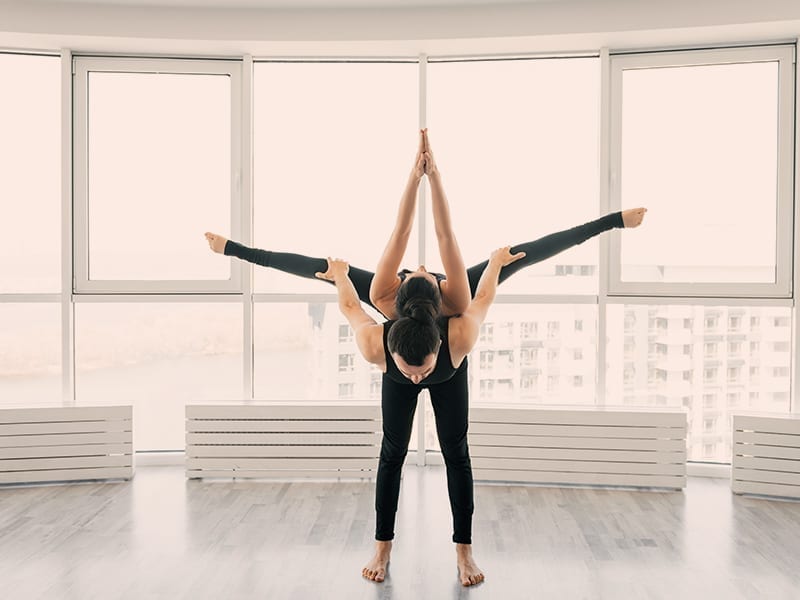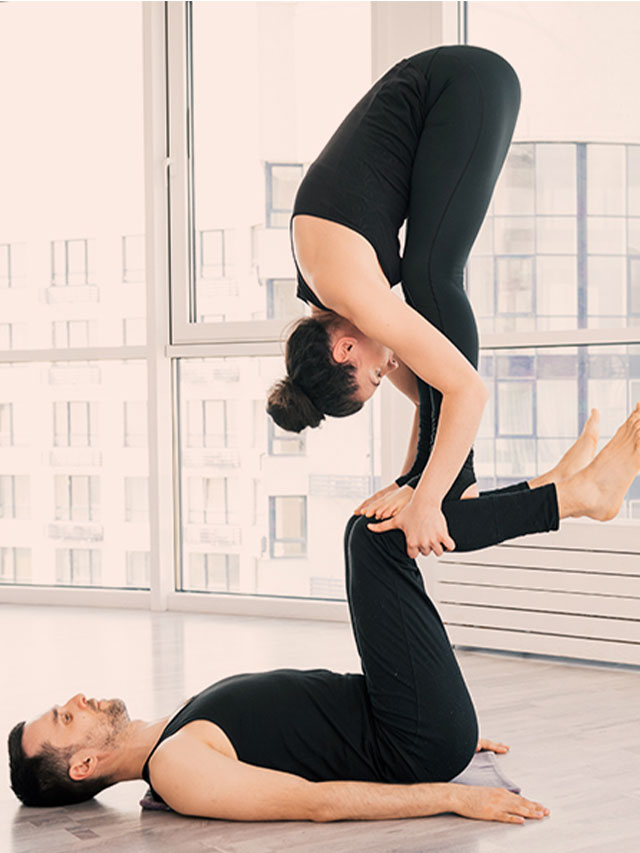Couples yoga is a shared experience focused more on the connection with one another rather than just yourself. By engaging in couples yoga poses with your partner, you are accessing a whole new realm of benefits for both you as individuals and for your relationship together. Make note, your partner doesn’t necessarily have to be a romantic partner. The benefits of these yoga asanas can be enjoyed by any-duo, like two friends, siblings, mother and daughter, colleagues, workout partners, and more.
So what are some couples yoga asanas that are perfect for beginners and how does it benefit the relationship?
A proponent of yoga and the Founder of Sohan Yoga International, Sohan Singh shares what constitutes as couples or partner yoga, its effects on your relationship and some asanas for you and your partner.
1. What is partner yoga?

Couple/Partner yoga is a form of yoga designed to connect with your partner physiologically and physically. Its regular practice in sequence flow and posture builds confidence and enhances communication, all with a sense of light-heartedness and laughter. This form of yoga sparks closeness by bringing together two people making use of breath, touch, play, movement, and intimacy. It is a wonderful way to explore your relationship with your partner, sibling, friends, and family by changing the intimacy level (based on who you’re performing the asanas with).
2. How can it help strengthen the relationship?
This form of yoga starts with the body at the physical level and then bursts to the spiritual level through a deep connection between the two partners. So, this form of yoga focuses on knowing relationships rather than concentrating on a person. The routine is structured in a way that incorporates this understanding and trust when you and your partner get into a Couple/Partner Yoga practice. A great deal of communication is involved in verbal and non-verbal cues where both the partners listen to each other verbally and through their body movements. Couple/Partner Yoga is an act designed for two people, so supporting one another physically and mentally involves doing some yoga asanas. It also requires trust for somebody to support or assist you through bodyweight.
3. How can it boost health, form, & posture?
The couples/partners who practice this form of yoga get into a new level of stability and peace. It helps to increase contact, confidence, equilibrium, harmony, and obligation as well as a new and hyped charisma between the two. It also boosts emotional support.
Any form of exercise has always shown a positive effect on the human body. When you perform the asanas with your partner, it still is a form of exercise that helps to keep your body toned and fresh. Since yoga helps you meditate, it improves your mental health.
Yoga also boasts about strengthening the human body while improving one’s posture. When your posture gets better, by and by, the form of your asanas also improves.
5 Step-By-Step Yoga Asanas For Beginners In Couples Yoga
1. Double Dancer Pose (Nataraja Asana)
- Start by facing your partner a little less than the distance apart from the mat.
- You can have the same front leg or legs in opposition – it doesn’t matter.
- Extend your front leg arm upward as you take hold of the outside of your back ankle into Dancer’s Pose.
- Bring forward your front arm to rest on top of your partner’s; hands will be at the top of your arms.
2. Lifted Bow (Dhanurasana)
- Start similar to the Lifted Plank position, but position higher, hands-on shins (closer to the knees than to the ankles).
- Hands will be on shins rather than ankles.
3. Wide-Legged Boat Pose (Paripurna Nava-Asana)
- With your knees bent and far apart, your feet flat on the ground, your toes brushing your partner’s.
- Before doing anything–visualise this: you’ll be taking Happy Baby Pose, sitting upwards, pressing your feet into your partner’s, then straightening the legs.
- Reach between your legs to grab onto the hands of your partner.
- Lean back to lift both feet off the mat, taking your legs into an angle of approximately 90 degrees, so you can press the sole of your feet into your partner’s soles.
- Engage the stabilising heart as you straighten your legs into a straddle.
4. Double-Side Plank (Vasistha-Asana)
- Begin in preparation for the side plank facing away from each other (approximately 6-12” apart), “tops to toes”– feet will line up with wrists.
- Press the lower hand to lift into the board as you extend your upper arm diagonally upwards to meet your partner.
5. Seated Cat-Cow (Marjaryasana/Bidalasana)
- Remain seated and reach for each other’s forearms.
- Maintain a firm grip as you release your shoulders down and back.
- While inhaling, lift your chest up to the ceiling, allowing for a slight arch in your upper middle back.
- As you exhale, draw your chin into your chest, rounding through your upper middle back and spreading your shoulder blades wide apart.
- Continue the same movement for a few cycles of breath, and as you warm up your spine, you may lift your gaze up to the ceiling as you inhale and allow your gaze to fall to your belly button as you exhale.
- Do 10 to 12 rounds, developing trust while using the support of your partner to find a sense of spaciousness in your chest and upper back.
6 Cautionary Tips
- Make yourself and your partner comfortable first.
- Communicate. Tell each other what you want to work on first.
- If your partner or you are not comfortable performing an asana, step back. Take up another asana.
- Do not stretch your partner or yourself to an extent that hurts your body. Take precautions.
- Do not judge your partner for not being able to perform a particular pose.
- Do not pressure yourself to perform an asana you’re not comfortable with. Express openly.
